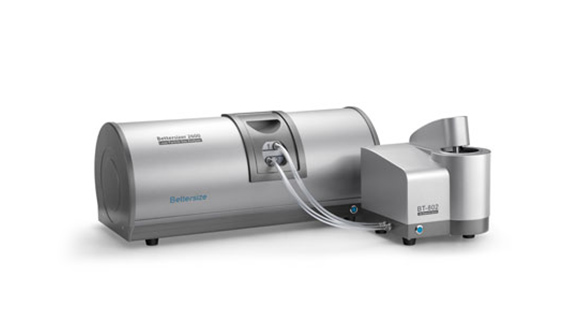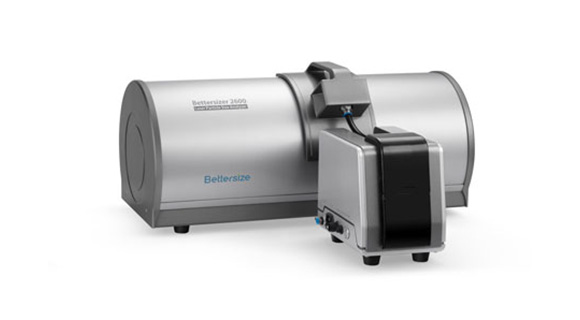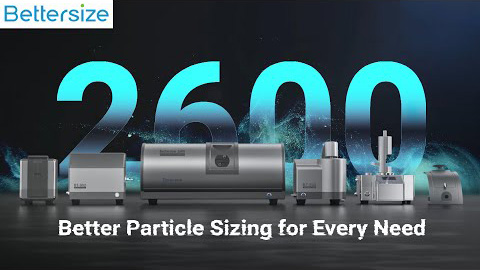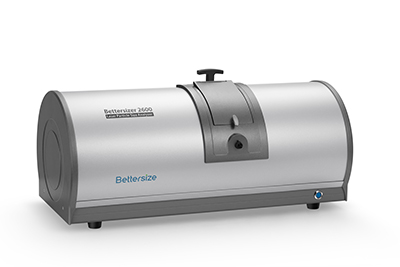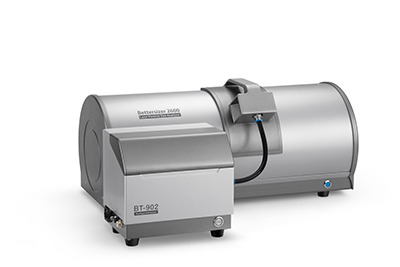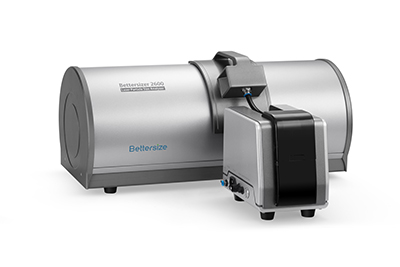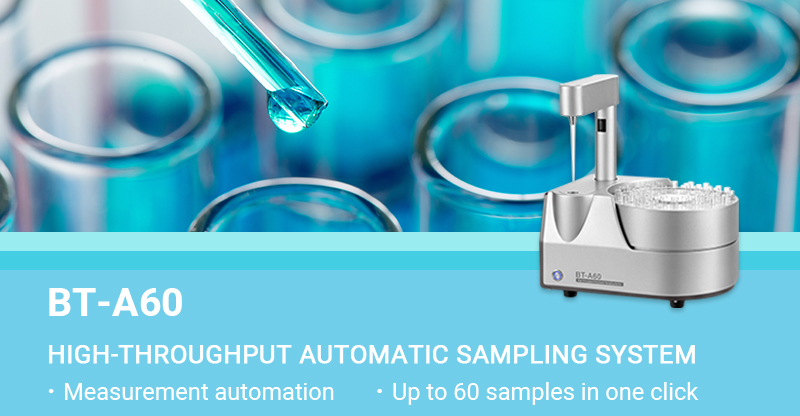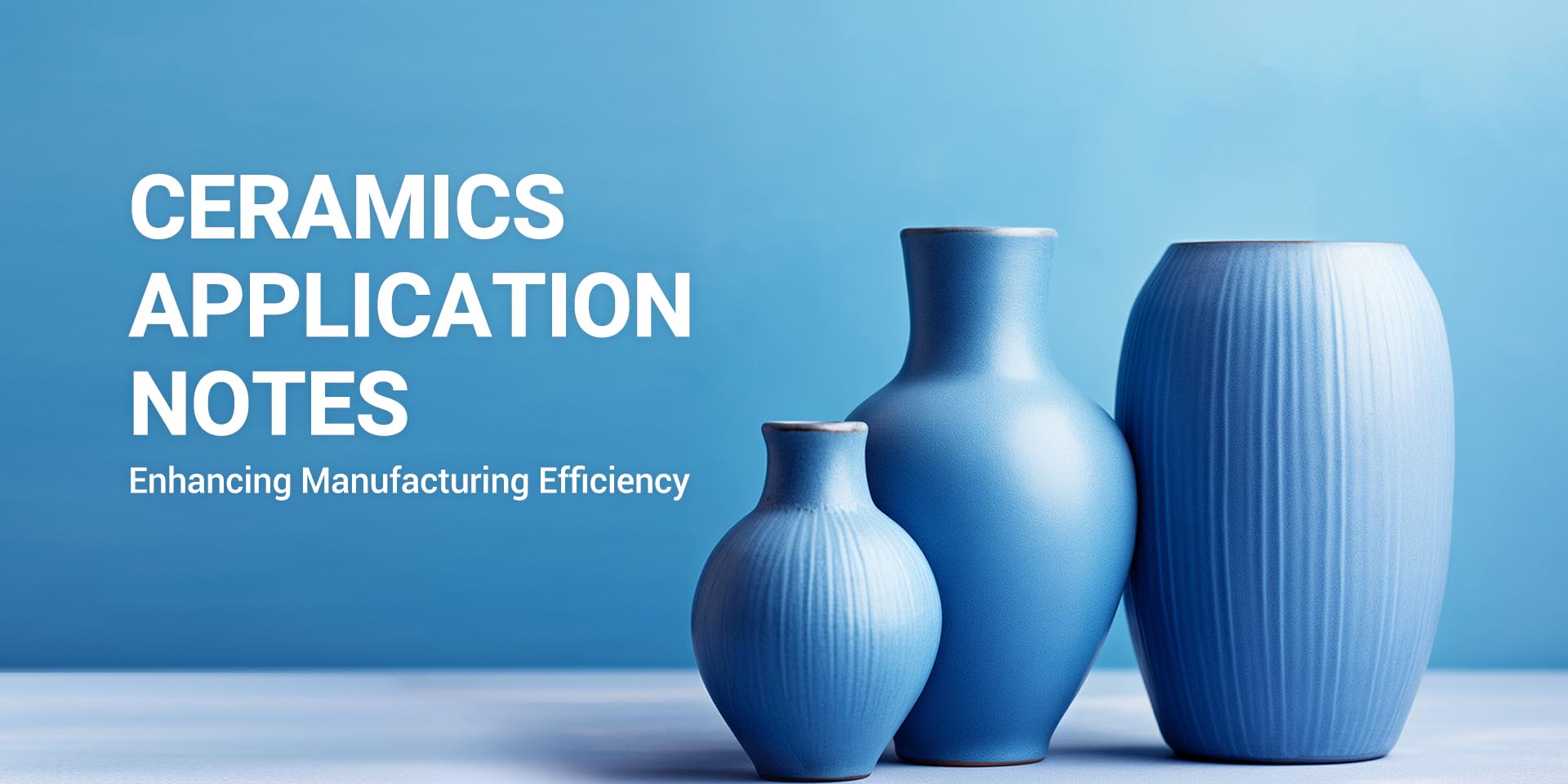Bettersizer 2600
O tamanho das partículas pode ser medido pelo método úmido ou seco, usando o Bettersizer 2600. Diversas aplicações foram cobertas por esse analisador versátil e potente, com seu design modular e tecnologias patenteadas. Os usuários podem caracterizar materiais de 0,02 μm a 2600 μm, com facilidade e precisão.
Recursos e benefícios
- ● Tecnologia: Difração de laser
- ● Faixa de tamanho de partícula: Dispersão úmida: 0,02 a 2.600μm Dispersão seca: 0,1 a 2.600μm
- ● O método úmido e seco de dimensionamento de partículas é adequado para uma ampla variedade de sistemas de partículas dispersas
- ● Medição precisa de partículas grandes e pequenas, abrangendo a mais ampla faixa, por meio de uma nova tecnologia patenteada que utiliza os sistemas ópticos de Fourier e de Fourier invertido
- ● Banco óptico com 92 detectores que cobrem uma faixa angular de 0,016° a 165° Dispersão úmida e/ou seca opcional
- ● Módulo de dispersão a seco de pequeno volume para pequenas quantidades de amostras, especialmente para amostras farmacêuticas ou valiosas com pouco estoque
- ● Troca fácil e rápida entre os módulos de dispersão
- ● Procedimentos de operação padrão fáceis de implementar, criar e usar para novos materiais
- ● Medição do índice de refração para fornecer um parâmetro mais preciso para calcular os resultados.
- ● Software fácil de usar e de aprender
Vídeo
Bettersizer 2600 | Laser Diffraction Particle Size Analyzer (Wet & Dry) 
Snippet - How to Measure Particle Size of Coffee Powder 
How to Install and Operate Bettersizer 2600 
Ask an Expert! Introducing Bettersizer 2600 
A Brief Introduction to Laser Diffraction | Fundamentals of Bettersizer 2600 
Bettersizer 2600 Demonstration with Corundum (Al2O3) sample 
How to Measure Particle Size of Cosmetics 
How to Measure Particle Size of Coffee Powder 
Bettersizer 2600 Overview | Laser Diffraction Particle Size Analyzer (Dry & Wet Dispersions) 
Visão geral
1. Sistema óptico de Fourier e de Fourier inverso
O Bettersizer 2600 é superior na combinação dos designs de Fourier e Fourier inverso. Esse design inteligente permite, por um lado, a detecção de luz dispersa em uma faixa angular muito ampla, de 0,016° a 165°. Por outro lado, em contraste com o design de Fourier inverso, as partículas não precisam estar em um único plano - a medição precisa simultânea de partículas pequenas e grandes é, portanto, obtida.
Recursos da combinação do design de Fourier e Fourier inverso
- Conjunto de detectores esféricos: Detectores para frente, laterais e para trás em um total de 92 peças;
- Lente de Fourier supergrande;
- Tamanho reduzido: Design compacto para economizar espaço.

2. Software intuitivo e avançado
- Interface de usuário intuitiva e operação ordenada
- Curva PSD em tempo real para determinar as condições ideais de medição
- Rotina de medição totalmente automática
- Rotina de limpeza automática
- Backup automático de dados e relatórios altamente personalizáveis
- Conversão direta de acordo com os modelos de avaliação Fraunhofer e Mie
- Alternância entre módulos de dispersão úmida e seca com um clique
3. Dispersão úmida
O BT-802 foi projetado para medição de tamanho de partículas com água como meio.


| Etanol | Metanol | Isopropanol | Éter |
| Tolueno | Xileno | Diclorometano | Octano |
| Acetato de etila | Acetona | Oleato de metila | Solventes NMP |
O BT-80N é feito de uma carcaça de aço inoxidável. Seus componentes incluem uma bomba centrífuga, um dispersor ultrassônico, uma tubulação de PTFE, uma célula de amostra de quartzo sinterizado, um circuito de controle, etc.



O BT-804 foi projetado para medições de amostras valiosas ou de pequeno volume, em que o meio é solvente ou água. O módulo consiste em um invólucro de ABS, um motor de agitação, uma cubeta (8 ml), um agitador, etc.
- Volume máximo de 8 ml com massa de amostra de 0,005 a 0,1 g.
- Adequado para amostras dispersas em água ou fase orgânica.
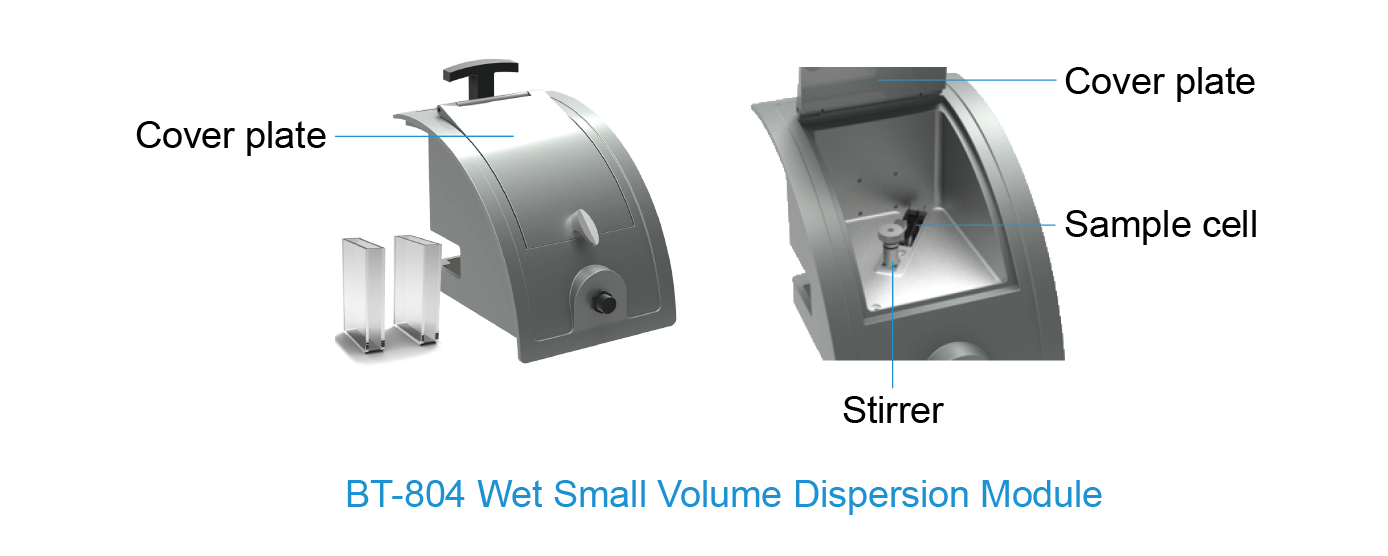

4. Dispersão a seco
O BT-902 é adequado para medições de pó seco. O gás usado pode ser ar comprimido, nitrogênio ou outros gases nobres.
O BT-902 é composto por um alimentador de vibração eletromagnética, um tubo venturi, um circuito de gás, um circuito elétrico, um sensor de pressão, etc.




5. Aplicações

Citations
- Bettersizer 2600
Functional redundancy as an indicator for evaluating functional diversity of macrobenthos under the mussel raft farm near Gouqi Island
DOI: 10.1016/j.aquaculture.2023.740024 Read ArticleZhejiang Ocean University | 2024Biological traits analysis (BTA) helps to evaluate the effects of different environmental variables on the traits-based functional composition of macrobenthos. However, research on functional traits of macrobenthos under mussel farming is limited. We investigated the spatial and temporal response of the benthic system in terms of taxonomic and functional diversity to environmental variables of farming and natural stressors resulting from suspended mussel farming near Gouqi Island of eastern China Sea. The functional traits of macrobenthic assemblages under mussel farming were characterized by “medium adult body size”, “vermiform body form”, “high flexibility”, “infauna”, “semi-motile”, “gonochoristic”, “surface deposit-feeders”, “carnivores”, “semi-motile burrowers”, and “tube-dwellers”. Functional redundancy was stable in response to mussel farming stresses among seasons, whereas species diversity showed efficient to evaluate natural variables. Functional diversity was significantly affected by farming stressors rather than natural variables, Further analysis using multivariate methods together with continuous monitoring were highlighted to evaluate the impacts of mussel farming. Our results reinforce the importance of macrobenthic species and functional traits analysis to evaluate human stresses driven impacts in offshore ecosystems. By analysing the environmental variables with different sources, independently, we concluded the main effects of human pressures on macrobenthic community. Such distinction could be particularly effective to isolate variable environmental descriptors and evaluate their effects on functional diversity, making the current approach promising for the evaluation of ecological effects of anthropogenic stressors in aquaculture areas. - Bettersizer 2600
Degradation characteristics and utilization strategies of a covalent bonded resin-based solid amine during capturing CO2 from flue gas
DOI: 10.1016/j.seppur.2023.125621 Read ArticleChina University of Petroleum | 2024In this study, various types of degradation as well as attrition which are possibly encountered in a circulating fluidized bed temperature swing adsorption (CFB-TSA) process, were conducted experimentally to evaluate the stability of a resin-based solid amine sorbent. Other characterizations methods, such as elemental analysis (EA), Fourier transform infrared spectroscopy (FTIR) etc. were applied to further reveal the degradation mechanisms. The results showed that thermal degradation occurs from 140–160 °C due to the decomposition of amine group. The CO2-induced degradation occurs from a higher temperature of 160–180 °C accompanied by the production of urea. Hydrothermal stability is good below 130 °C, but the ionic impurities in steam crystalized on particle surface can accelerate the degradation. Oxidative degradation is the most harmful, which starts at a lower temperature of 70–80 °C with the formation of aldehyde. The existence of H2O in atmosphere can alleviate the oxidative and CO2-induced degradations. The employed sorbent has a very low attrition index of 0.05, which is 1–2 orders lower than typical commercial fluidized bed catalysts. Based on the results of stability evaluation, some design suggestions for proper utilization of this sorbent or other similar resin-based sorbents have been provided in an industrial CFB-TSA process.
- Bettersizer 2600
De-branching of starch molecules enhanced the complexation with chitosan and its potential utilization for delivering hydrophobic compounds
DOI: 10.1016/j.foodhyd.2023.109498 Read ArticleShihezi University | 2024The current study aimed to prepare the complexes between debranched-waxy corn starch and chitosan polymers (DBS-CS), and then investigated their corresponding structural characteristics, rheological property and potent application in Pickering emulsion. The results indicated that the existence of chitosan significantly inhibited starch short-range molecular rearrangement for all DBS-CS samples, which was manipulated by both debranching treatment and chitosan content. Interestingly, this is the first study to reveal that the outstanding peak at 1.8 ppm in 1H NMR spectrum for sample DBS-CS was gradually shifted towards a lower-field region following an increased chitosan content. Moreover, the debranching treatment shifted the crystallinity pattern from A-type to B-type and the relative crystallinity of DBS-CS decreased gradually with the increased content of CS. All samples had a pseudoplastic fluid and shear-thinning behavior with an enhanced shear resistance following the complexation. The DBS-CS was applied in a Pickering emulsion for showing a greater emulsifying stability and a lower gel strength than native NS-CS prepared emulsion. Importantly, the encapsulation ability of curcumin in the DBS-CS emulsion was significantly improved, followed by an increase of 15.45% for its corresponding bioavailability compared to the control. Therefore, this study might highlight a potential carrier for delivering the bioactive substances in a green pattern. - Bettersizer 2600
Heat-induced aggregation behavior of wheat gluten after adding citrus pectin with different esterification degree
DOI: 10.1016/j.foodhyd.2023.109420 Read ArticleGansu Agricultural University | 2024Wheat gluten aggregation during heat treatment is beneficial to the final quality of gluten-based products. Exogenous pectin can affect gluten aggregation. However, the effect of pectin with different degrees of esterification on the heat-induced aggregation behavior of gluten and its possible mechanism are still unclear. Thus, the heat-induced aggregation behavior of gluten after adding pectin with different esterification degree was studied in this study. When the temperature was raised from 25 °C to 95 °C, pectin affected gluten aggregation and was related to the degree of esterification. Specifically, the results of rheological properties and particle size indicated that low-ester pectin improved the viscoelasticity of gluten and promoted gluten aggregation. Thermal properties revealed that enthalpy of gluten added with low-ester pectin (37%) increased from 92.96 J/g to 95.40 J/g during heating process. Structurally, the fluorescence intensity and surface hydrophobicity of gluten added with low-ester pectin (37%) were lower than those added with high-ester pectin (73%). In addition, low-ester pectin (37%) significantly increased the disulfide bond content (from 15.31 μmol/g to 18.06 μmol/g) and maintained β-sheet content of gluten compared with gluten alone at 95 °C, indicating that low-ester pectin was more likely to induce gluten aggregation. However, scanning electron microscope showed that the gluten added with low-ester pectin (46%) exhibited a denser network structure at 95 °C than that added with low-ester pectin (37%). These results will provide a theoretical base for the regulation of gluten aggregation and the quality of gluten-based products by pectin with different esterification degree.
- 1
- 2
- 3
- 4
- 5
- 6
- 84
Recursos selecionados
Depoimentos


Analisador de tamanho de partícula relacionado
-
BeScan Lab
Stability Analyzer
Particle size ranges from 10 nm to 1 mm
Volume fraction up to 95%
Compliance with ISO/TR 18811, 13097, 21357, 22107
-
Bettersizer S3 Plus
Particle Size and Shape Analyzer
Measurement range: 0.01 - 3,500μm (Laser System)
Measurement range: 2 - 3,500μm (Image System)
-
Bettersizer ST
One-stop Particle Size Analyzer
Dispersion type: Wet
Measurement range: 0.1 - 1,000µm
Repeatability: ≤1% variation
-
BT-Online1
Online Particle Size Analyzer
Dispersion type: Dry
Measurement range: 0.1 - 1,000μm
Accuracy: ≤1% (D50 of certified reference material)




